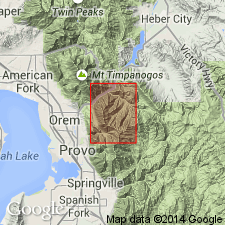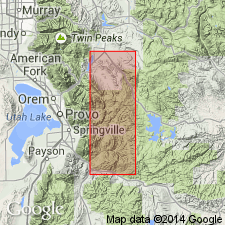
- Usage in publication:
-
- Shingle Mill Limestone Member*
- Modifications:
-
- Named
- Dominant lithology:
-
- Limestone
- AAPG geologic province:
-
- Wasatch uplift
Summary:
Unit is named the Shingle Mill Limestone Member of the Oquirrh Formation. Consists of gray and tan ledge-forming limestone with chert nodules. Thickness ranges from 61 to 137 m. Overlies and underlies unnamed quartzitic sandstone members. Age is Middle Pennsylvanian (Desmoinesian). (B1520) [MENLO GNU STAFF (1996)]
Source: GNU records (USGS DDS-6; Menlo GNULEX).

- Usage in publication:
-
- Shingle Mill Limestone Member*
- Modifications:
-
- Named
- Dominant lithology:
-
- Limestone
- Chert
- AAPG geologic province:
-
- Uinta basin
Summary:
Named as a member of Oquirrh Formation in Uinta basin. Derivation of name and type locality not stated. Consists of dark-gray thin bedded limestone with abundant dark-gray to black bedded chert. Is 250 to 450 ft thick. Overlies Bear Canyon Member (new); underlies Wallsburg Ridge Member (new), both of Oquirrh. Des Moinesian or Middle Pennsylvanian fusulinids collected. [DENVER GNU STAFF (1996)]
Source: GNU records (USGS DDS-6; Denver GNULEX).
For more information, please contact Nancy Stamm, Geologic Names Committee Secretary.
Asterisk (*) indicates published by U.S. Geological Survey authors.
"No current usage" (†) implies that a name has been abandoned or has fallen into disuse. Former usage and, if known, replacement name given in parentheses ( ).
Slash (/) indicates name conflicts with nomenclatural guidelines (CSN, 1933; ACSN, 1961, 1970; NACSN, 1983, 2005, 2021). May be explained within brackets ([ ]).

